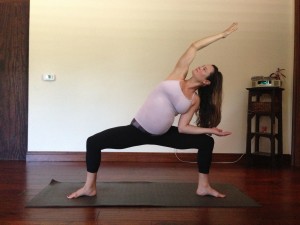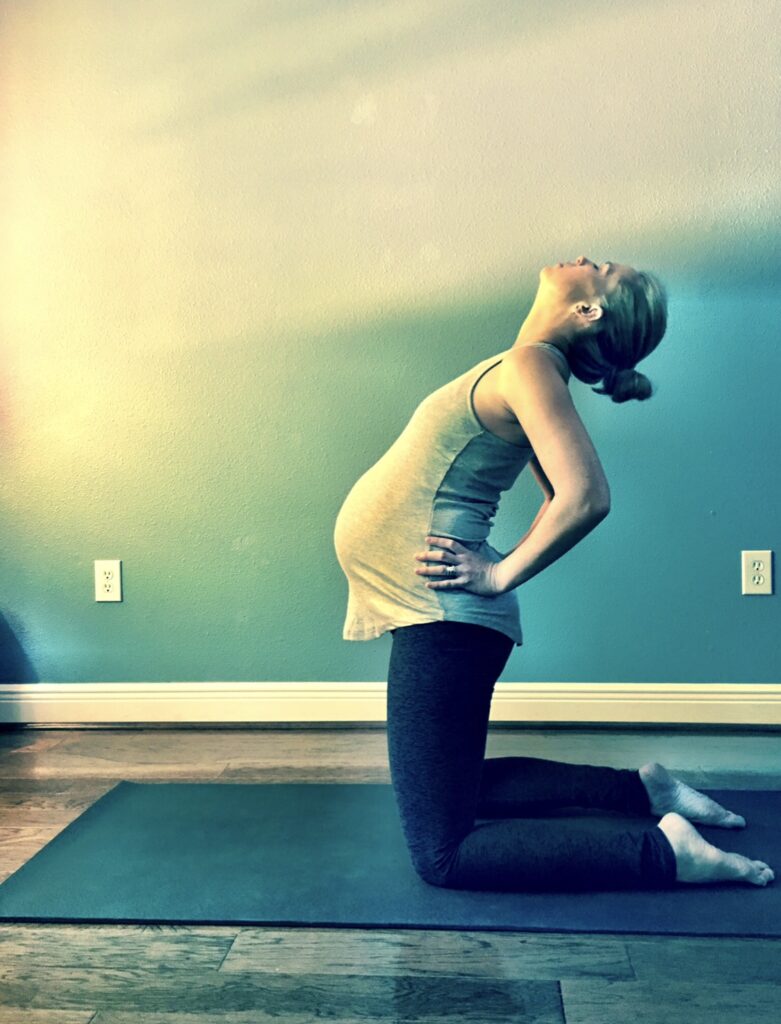 These guidelines are for the experienced Yoga practitioner with a normal pregnancy. Pregnancy is a very special time to become more in tune with the amazing process going on within and to learn more about oneself. Trust the process, slow down, and focus on each moment by drawing your attention to your breath. Notice when you bring consciousness to your breath allowing it to extend in a calm smooth pattern, the same will occur in the mind. The mind will become calm and one will feel ease, providing the opportunity to align with your true nature. Yoga Mala offers pregnancy guidelines, which I have included.
These guidelines are for the experienced Yoga practitioner with a normal pregnancy. Pregnancy is a very special time to become more in tune with the amazing process going on within and to learn more about oneself. Trust the process, slow down, and focus on each moment by drawing your attention to your breath. Notice when you bring consciousness to your breath allowing it to extend in a calm smooth pattern, the same will occur in the mind. The mind will become calm and one will feel ease, providing the opportunity to align with your true nature. Yoga Mala offers pregnancy guidelines, which I have included.
• If you are relatively new to Yoga, you should enroll in a gentle prenatal yoga class instead, or practice under the close supervision of a qualified Yoga teacher who has experience with pregnancy.
• The pregnant Yoga practitioner can cultivate mindfulness of the new life growing inside her while preparing her body for delivery and postpartum recovery.
• Yoga practice during pregnancy should be modified to accommodate the growing baby and protect the placenta.
• If you experience cramping, bleeding or prolonged cessation of fetal movement, stop practicing immediately and call your doctor.
• Always practice as if the belly (your baby) were larger than it actually is. Adjust your pregnancy yoga practice to a lower level and intensity than that of your pre-pregnancy practice.
• Often in early pregnancy, the “listen to your body” principle holds little meaning because your body is still very accustomed to its pre-pregnancy state of conditioning. Your pregnant body does not really start to tell you what it wants until the fourth month or beyond.
• You want to minimize the risks of a rigorous yoga practice during pregnancy while you can still reap the benefits of the practice both during and after pregnancy.
• Intuition and Baby: If something does not feel right, or if your baby seems to object to a certain pose, do not do the pose. Every pregnancy is different. Tune into your body and honor how you are feeling, because every woman´s pregnancy experience is unique.
• Pregnancy is not the time to try anything new. If you do not have an existing practice, seek out a pre-natal yoga class specifically designed to be safe for your changing body during pregnancy. Pre-natal yoga classes are designed for the pregnant mothers changing body and will offer a safe and sound practice.
• Drink small quantities of water during practice to prevent dehydration and uterine contractions. Make sure the room is not too hot, as you do not want your body to over heat. Don’t try to work up a huge sweat.
First Trimester
The decision to practice yoga during the first trimester is an individual matter. It must be emphasized that Sri K. Pattabhi Jois advises women not to practice Ashtanga Yoga at all during the first trimester. This advice makes particular sense if one has experienced a miscarriage or when high-risk pregnancy factors are present. Since one generally does not know whether a pregnancy is high-risk until second trimester or later, it is advisable to take a conservative approach to one’s practice, beginning with the first trimester.
Second Trimester
If you have severe morning sickness, it is advisable to wait for the morning sickness to end (usually by Month 4) before resuming a regular yoga practice. If your morning sickness is not severe and you feel good practicing, try not to practice on an empty stomach. Drink small quantities of water during practice to prevent dehydration and uterine contractions. Make sure the room is not too hot. Don’t try to work up a huge sweat.
• Modify vinyasa between poses: No jumping, jump-throughs, jump-backs, chakrasana, or rolling. Step or crawl instead. If you have a petite frame, it would be advisable to eliminate the jumping movements as early as possible because your uterus may feel less cushioned from the impact than in someone with a larger frame.
• Ujjayi Pranayama: OK to do (Yoga Mala, 27), but be mindful of the strength of your bandhas, if you are a seasoned Ashtanga Yoga practitioner.
Bandhas
• Uddiyana bandha: Practice releasing uddiyana bandha downward in preparation for labor. Your belly needs space to grow; actively tightening and lifting the abdominal muscles at this stage is unnecessary. Sometimes, performing uddiyana bandha during pregnancy will cause nausea.
• Mula bandha: Mula bandha may be performed if you can engage the muscles near the cervix without causing uterine contractions. When the baby rises higher (e.g., Month 5 or 6), mula bandha may feel more comfortable to do.
• Sun Salutation A: In the forward-bending movements, keep the chest at least 80-85 degrees from the floor. Place the hands in front of the feet rather than aligned with the feet. Step rather than jump. When you first start to show or feel your belly just needs the extra space, start the sequence with the feet hip-width apart in samasthiti before you forward fold.
• Sun Salutation B: When stepping forward from downward dog into a lunge, allow the back heel of the back foot to lift off the floor (but keep the ball of the foot firmly planted) to avoid triggering uddiyana bandha and compression of the belly. After your front foot is stabilized in the lunge position, set the back heel back down on the floor at the usual 80-85 degree angle to the front foot. Keep the back leg and back foot active and firm in the virabhadrasana position.
• Start the sequence with feet hip-width apart in samasthiti in Month 6 or whenever more space is required.
Omit the Following Postures:
• Extreme Twists, which may cause placental abruption: Utthita trikonasana B, Utthita parsvakonasana B, Marichyasana C, Marichyasana D, etc. (Yoga Mala, 87 “Pregnant women should not practice this asana after the second month.”)
• Poses that press the heel into the uterus while folding or sitting. Ardha baddha padmottanasana (Yoga Mala, 63) (Modification: don’t fold, and wrap the arm behind the back to grasp the big toe only if the belly does not feel uncomfortably tight in this position)
Janu sirsasana C, Marichyasana B, Marichyasana D, (Yoga Mala, 104 n.44]
Garbha pindasana, (Yoga Mala, 104 n.44]
(modification: sit in an easy cross-legged position and don’t roll)
Seated lotus and half-lotus poses generally, unless you can keep the lotus very loose and not tweak the knees.
• Poses on the belly or that would compress the belly. Bhujapidasana, Kurmasana, Supta kurmasana, & Second Series poses of this nature.
• Forward bending (standing or seated) in general. When folding forward, keep the chest at least 80-85 degrees from the floor, particularly in poses that place the legs together. Focus on pulling up rather than folding forward. If you prefer, spread the legs at a wider angle but keep the chest lifted.
• Supta padangusthasana Omit (Yoga Mala, 101). This sequence of movements requires some time on the back and may encourage overcompression of the belly as one presses the leg to the face and then to the floor. If you choose to do this pose, do not force the leg to meet either the face or the floor. Instead, focus on extending the heel away from the hip while firming the inner thigh and straightening the leg.
• Setu bandhasana: Omit after Month 4 (Yoga Mala, 103-104). This pose requires exertion from the abdominal muscles (uddiyana bandha) to stabilize the bridge shape of the pose; risk of straining the neck, losing balance and falling due to pregnancy weight gain.
• Inverted postures: Omit headstand (Yoga Mala, 116 “Pregnant women should not practice this asana.” Referring to Headstand). If you choose to practice headstand and shoulderstand, make sure that you can maintain your balance, consistently build up the strength in the neck and arms to keep up with the weight gain, and that you do not have blood pressure problems. Since inversions will normally trigger uddiyana bandha during the entry and exit of the pose, there could be strain to the abdominal area. If you experience nausea or strain in the abdominal area while entering or exiting an inverted pose, do not continue with the pose.
Hand position in seated poses: To avoid compressing the belly, relinquish the traditional hand position of placing the hand around the middle of the foot. Instead, hold your toes or big toe while keeping the held foot as flexed as possible.
Navasana: Alternate each set with one foot on the floor while extending the other leg. Having one foot on the floor will help with balance and prevent strain on the lower back and abdominal area. If you feel any gripping of the belly, omit.
Once you get into your third trimester, omit Baddha konasana and wide angle poses: The muscles and ligaments in the groin and sacroiliac area are more relaxed during pregnancy, so be careful not to overstretch in these positions.
Utthita Hasta Padangusthasana: As the belly becomes more prominent, move the leg to the side of the belly rather than the front. Work on lengthening the leg away from you rather than folding towards it.
Poses on the back: To avoid reducing the blood flow to the uterus, do not stay on the back for more than 3 minutes at a time. If you experience difficulty breathing, nausea, or dizziness while doing poses on your back, omit such poses altogether. Final resting posture and/or savasana should be on left side, supported.
Backbends: In upward dog, keep the belly soft and move into the arch deliberately and slowly, concentrating on keeping the hands flat on the floor and the arms straight. If there is any undue tightness in upward dog, do not do full backbends. The placement of the placenta and the individual angle of your uterus may influence your ability to do full backbends, so don’t worry if you have to give up backbends. If you can do backbends comfortably, work into the arch slowly and do not try to make it perfect or tight. The belly should not feel tight or uncomfortable. Allow the psoas, frontal hip-bones, and tops of the thighs to soften. Pay attention to whether your lower back is tightening in the backbends. Due to the increased weight of the belly, the lower back naturally tightens over time to support the front of the body, so avoid inadvertently tightening the lower back during back-bending as well. However, even slight back-bending will help “pop” the spine and alleviate backaches from the weight gain. Skip drop-backs, since there is a risk of over stretching the abdominal muscles in these movements. An alternative to full back-bending is the modified bridge pose.
Savasana: Lie on your left side in a fetal position to avoid compressing the blood flow to the uterus. Use a rolled towel or mat under your head to make the neck more comfortable. You can also place a rolled blanket or bolster between your legs and hold one between your arms to make your belly more comfortable.
Third Trimester
All of the above guidelines plus the following: The last 8 weeks of pregnancy are a time to encourage the downward flow of energy and the correct downward positioning of the baby’s head to facilitate labor.
Suryanamaskar A & B: Continue placing the hands in front of the feet in the forward-bending movements, using the fingertips rather than the palms to touch the floor in dwi and trini (the second and third vinyasas) and the like. If the belly becomes so large (e.g., Month 8) that it becomes too difficult to step forward in suryanamaskar B without straining the hip or front knee, omit suryanamaskar B and substitute suryanamskar A (total 7-10 A’s).
Hand position in seated poses: Instead of holding your toes with both hands, slide one hand up to the wrist or forearm of the opposite arm while continuing to lengthen the chest. Example: In janu sirsasana A, with right leg folded in and left leg extended, pull back the toes on your left foot with your left hand while holding your left wrist or forearm with your right hand. This modification allows you to maintain the hand-foot energy flow in the forward bends while providing support for the lower back.
Forward bends: Adjust legs to hip-width or wider distance to accommodate the growing belly. For the last 6 weeks of the pregnancy, omit navasana and other poses that involve a reclined position (where the knees are higher than the pelvis), which can work against optimal fetal positioning.
Inverted postures (headstand, shoulderstand): Inverted postures such as headstand and shoulderstand are strongly discouraged at this stage because they may adversely affect blood flow to the baby, place undue pressure on the placenta, and increase the risk of the umbilical cord becoming wrapped around the baby’s neck. One must consider that not all babies are “athletic” enough to extricate themselves as the amount of relative space in the uterus decreases; or perhaps in women who have had multiple pregnancies and the uterus is more spacious, it may be easier for the baby to flip around but remain in a breech position.
Labor and Delivery
Practicing yoga before and during pregnancy can improve a woman’s stamina and confidence during labor and delivery. The progress of a woman’s labor is a very individual matter and depends on many variables, including the woman’s family history of delivery, the proportionality of the baby’s head size to the size of the woman’s pelvis, the position of the baby, and the amount of dilation and effacement existing at the onset of labor. Being healthy from yoga practice is likely to facilitate the proper release of the hormones necessary for a normal (vaginal) labor and delivery. The disciplined breathing techniques learned from Yoga may help somewhat with pain management. The conditioning gained from mula bandha may help you push the baby out more efficiently than without such conditioning. If you opt for pain relief, the practice of yoga may still help you sense the contractions sufficiently for you to feel that you are not relying exclusively on external cues to deliver your baby. Whatever happens, be open to the unexpected!
Postpartum
Wait three months after giving birth before resuming the kind of practice you did prior to your pregnancy. Once you do begin your practice, especially Ashtanga style of yoga, do so mindfully, not to over do it. Restorative, Yoga Nidra, and Gentle Yoga will be wonderful as you allow your body time and space to recover fully. This waiting period allows your uterus to shrink without interference. Since Ashtanga Yoga directs energy upward, wait until all of the lochia has been expelled from your uterus to avoid causing cramping and prolonged bleeding. Another reason to wait 3 months is that the muscles, ligaments and joints are still soft from the pregnancy and birth, making you more prone to injuries during this postpartum period. When you do start practicing again, deepen the forward-bending movements very gradually. As early as is comfortable, resume the practice of mula bandha to firm up the perineum and prevent incontinence. Uddiyana bandha becomes easier to perform as the uterus shrinks down to its pre-pregnancy size. This is a great time to play and bond with your infant in Postnatal Yoga Classes.
Miscarriage
In the event of a miscarriage, wait at least one month before resuming yoga practice. Though you may feel the urge to work out your feelings of grief and loss through immediate yoga practice, your uterus needs time to return to its pre-pregnancy state.











